Effective Communication and Literacy in Nursing: A Case Study Analysis
VerifiedAdded on 2022/09/23
|8
|2011
|28
Report
AI Summary
This report delves into the critical role of communication and literacy in nursing practice, emphasizing their impact on patient care and outcomes. Through a detailed analysis of a provided case study, the report highlights the significance of therapeutic communication in building strong nurse-patient relationships and fostering patient satisfaction. The report underscores the importance of nurses possessing adequate knowledge and skills to assess patients' needs effectively, both medically and mentally. It examines the standards set by the Nursing and Midwifery Board of Australia, particularly focusing on the need for nurses to engage in professional, respectful, and trusting relationships with patients. The report also stresses the use of interpersonal skills like active listening and person-centered care. The report concludes that effective communication is a fundamental component of nursing, while poor communication acts as a barrier to improved health outcomes. It highlights the need for nurses to be compassionate and empathetic, providing a comfortable environment for patients and their families, along with educating them about their health conditions and treatment options.
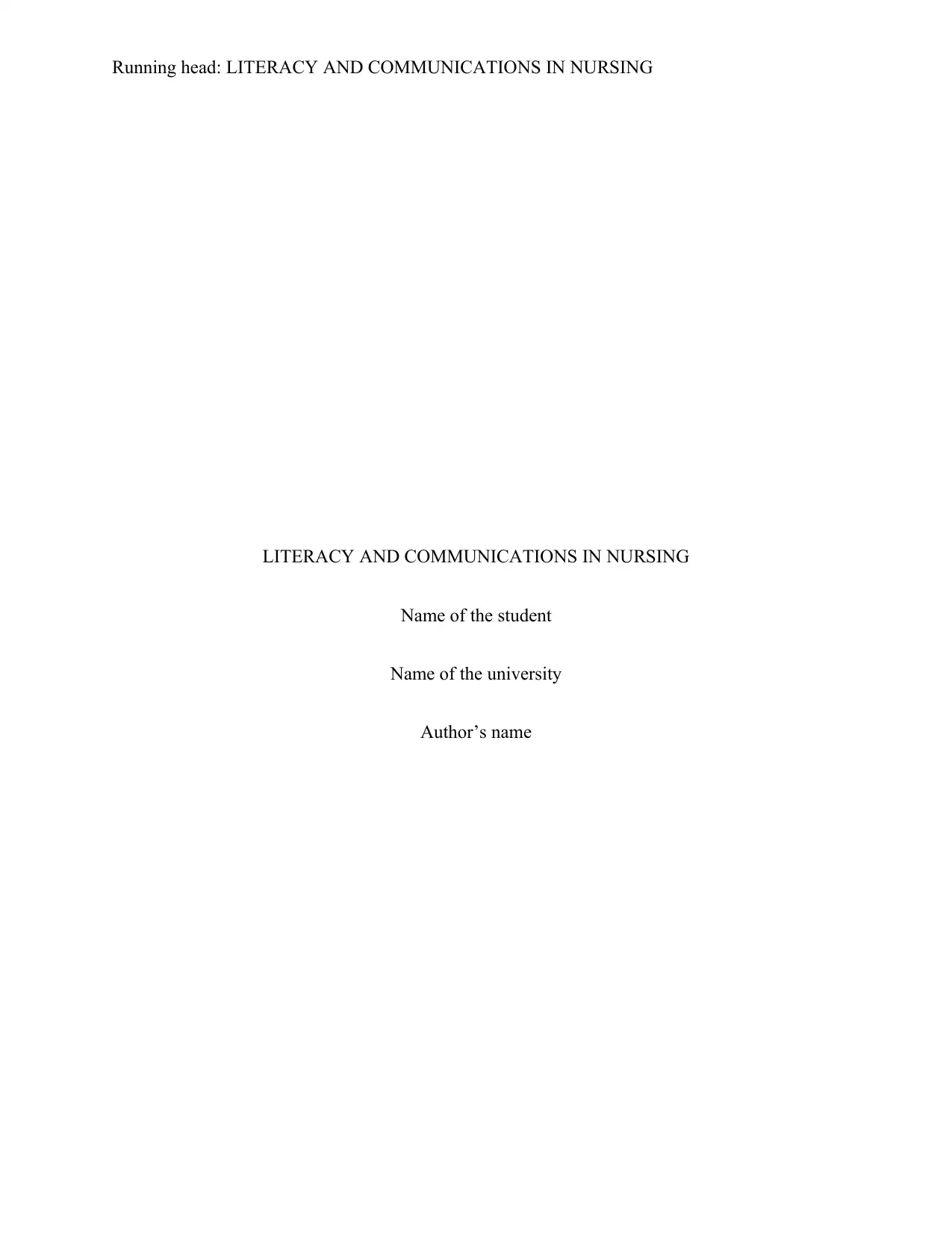
Running head: LITERACY AND COMMUNICATIONS IN NURSING
LITERACY AND COMMUNICATIONS IN NURSING
Name of the student
Name of the university
Author’s name
LITERACY AND COMMUNICATIONS IN NURSING
Name of the student
Name of the university
Author’s name
Paraphrase This Document
Need a fresh take? Get an instant paraphrase of this document with our AI Paraphraser
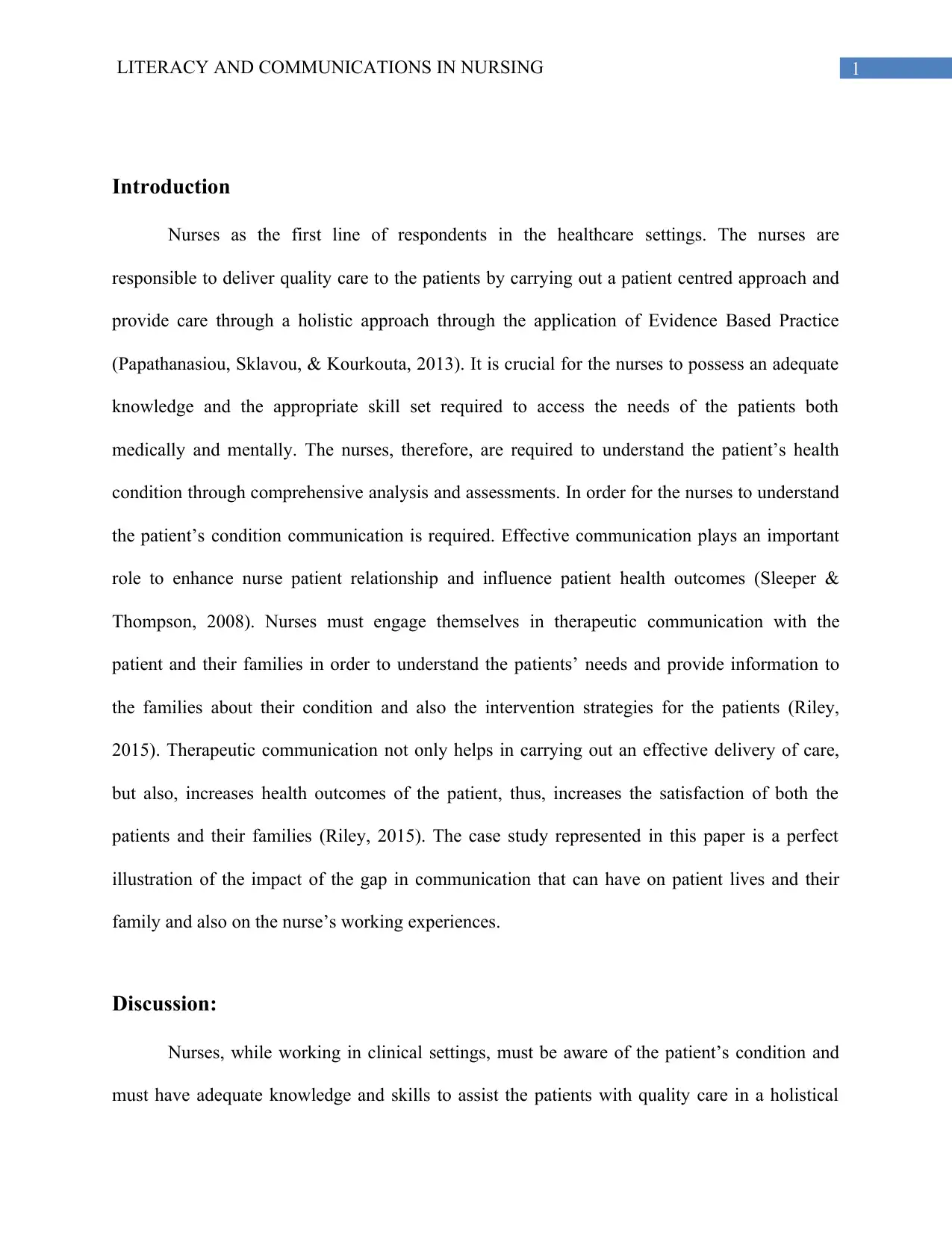
1LITERACY AND COMMUNICATIONS IN NURSING
Introduction
Nurses as the first line of respondents in the healthcare settings. The nurses are
responsible to deliver quality care to the patients by carrying out a patient centred approach and
provide care through a holistic approach through the application of Evidence Based Practice
(Papathanasiou, Sklavou, & Kourkouta, 2013). It is crucial for the nurses to possess an adequate
knowledge and the appropriate skill set required to access the needs of the patients both
medically and mentally. The nurses, therefore, are required to understand the patient’s health
condition through comprehensive analysis and assessments. In order for the nurses to understand
the patient’s condition communication is required. Effective communication plays an important
role to enhance nurse patient relationship and influence patient health outcomes (Sleeper &
Thompson, 2008). Nurses must engage themselves in therapeutic communication with the
patient and their families in order to understand the patients’ needs and provide information to
the families about their condition and also the intervention strategies for the patients (Riley,
2015). Therapeutic communication not only helps in carrying out an effective delivery of care,
but also, increases health outcomes of the patient, thus, increases the satisfaction of both the
patients and their families (Riley, 2015). The case study represented in this paper is a perfect
illustration of the impact of the gap in communication that can have on patient lives and their
family and also on the nurse’s working experiences.
Discussion:
Nurses, while working in clinical settings, must be aware of the patient’s condition and
must have adequate knowledge and skills to assist the patients with quality care in a holistical
Introduction
Nurses as the first line of respondents in the healthcare settings. The nurses are
responsible to deliver quality care to the patients by carrying out a patient centred approach and
provide care through a holistic approach through the application of Evidence Based Practice
(Papathanasiou, Sklavou, & Kourkouta, 2013). It is crucial for the nurses to possess an adequate
knowledge and the appropriate skill set required to access the needs of the patients both
medically and mentally. The nurses, therefore, are required to understand the patient’s health
condition through comprehensive analysis and assessments. In order for the nurses to understand
the patient’s condition communication is required. Effective communication plays an important
role to enhance nurse patient relationship and influence patient health outcomes (Sleeper &
Thompson, 2008). Nurses must engage themselves in therapeutic communication with the
patient and their families in order to understand the patients’ needs and provide information to
the families about their condition and also the intervention strategies for the patients (Riley,
2015). Therapeutic communication not only helps in carrying out an effective delivery of care,
but also, increases health outcomes of the patient, thus, increases the satisfaction of both the
patients and their families (Riley, 2015). The case study represented in this paper is a perfect
illustration of the impact of the gap in communication that can have on patient lives and their
family and also on the nurse’s working experiences.
Discussion:
Nurses, while working in clinical settings, must be aware of the patient’s condition and
must have adequate knowledge and skills to assist the patients with quality care in a holistical

2LITERACY AND COMMUNICATIONS IN NURSING
approach (Papathanasiou, Sklavou, & Kourkouta, 2013). It is the responsibility of the nurses to
understand the patient’s condition though thorough analysis and assessment and then deliver
quality care by accessing both physical as well the mental need of the patients. Effective
communication between nurse and patient is an important factor to improve the quality of care
delivered to them leading to an improved health outcome of the patients. Communication is an
effective tool in nursing care since an effective communication helps in building a nurse patient
relationship that eventually leads to an improved health outcome, thereby, increases patient’s
satisfaction (Abdolrahimi, Ghiyasvandian, Zakerimoghadam & Ebadi, 2017).
In the above case study, the nurse who was taking care of the patient to whom she was a
stranger, the patient was feeling uncomfortable and not willing to be taken care of by the nurse.
The patient did not recognize that the nurse was there to help him and take care of him by giving
him appropriate treatment. It is natural for a patient to react in a certain way when he was
confronted with a new nurse he does not know and never talked to. The nurse shown here should
have initiated a conversation before commencing the treatment and assisting him with care. The
nurse should have introduced her first and provide the patient with a comfortable and engaging
environment to make him feel comfortable. Standard 2 of the Nursing and Midwifery Board of
Australia states that nurses must engage themselves in a professional relationship with the
patients by communicating effectively and therapeutically (Nursingmidwiferyboard.gov.au,
2019). The nurses must build up a relationship with the patients in the context of respect and
mutual trust. Instead of approaching to him for help, the nurse should have initiated a
conversation by talking to him softly. The patient was already having a lot of pain, it is quite
obvious for the patient to get annoyed by an unknown touch. According to the Nursing and
Midwifery Board of Australia standard 2, the nurses must provide support to the patients by
approach (Papathanasiou, Sklavou, & Kourkouta, 2013). It is the responsibility of the nurses to
understand the patient’s condition though thorough analysis and assessment and then deliver
quality care by accessing both physical as well the mental need of the patients. Effective
communication between nurse and patient is an important factor to improve the quality of care
delivered to them leading to an improved health outcome of the patients. Communication is an
effective tool in nursing care since an effective communication helps in building a nurse patient
relationship that eventually leads to an improved health outcome, thereby, increases patient’s
satisfaction (Abdolrahimi, Ghiyasvandian, Zakerimoghadam & Ebadi, 2017).
In the above case study, the nurse who was taking care of the patient to whom she was a
stranger, the patient was feeling uncomfortable and not willing to be taken care of by the nurse.
The patient did not recognize that the nurse was there to help him and take care of him by giving
him appropriate treatment. It is natural for a patient to react in a certain way when he was
confronted with a new nurse he does not know and never talked to. The nurse shown here should
have initiated a conversation before commencing the treatment and assisting him with care. The
nurse should have introduced her first and provide the patient with a comfortable and engaging
environment to make him feel comfortable. Standard 2 of the Nursing and Midwifery Board of
Australia states that nurses must engage themselves in a professional relationship with the
patients by communicating effectively and therapeutically (Nursingmidwiferyboard.gov.au,
2019). The nurses must build up a relationship with the patients in the context of respect and
mutual trust. Instead of approaching to him for help, the nurse should have initiated a
conversation by talking to him softly. The patient was already having a lot of pain, it is quite
obvious for the patient to get annoyed by an unknown touch. According to the Nursing and
Midwifery Board of Australia standard 2, the nurses must provide support to the patients by
⊘ This is a preview!⊘
Do you want full access?
Subscribe today to unlock all pages.

Trusted by 1+ million students worldwide

3LITERACY AND COMMUNICATIONS IN NURSING
engaging them in the therapeutic communication and professional relationship to get an
increased health outcome (Nursingmidwiferyboard.gov.au, 2019). The nurse in the case study
failed to build a nurse patient relationship through effective communication. Therapeutic
communication is an important aspect in maintaining nurse patient relationship. Therapeutic
communication if not maintained, creates a gap between the delivery of care by the nurses and
the patient’s needs (Riley, 2015). The nurses must use interpersonal skills such as listening
actively, responding to their questions and applying person centred care during therapeutic
communication process (Stein-Parbury, 2013). The nurses must be compassionate while
providing care and show empathy to the patient and their families (Abdolrahimi et al., 2017).
According to the NMBA standard 1, nurses should think critically and analyse a situation
before implementing intervention strategies, which was missing in the case study provided
(Nursingmidwiferyboard.gov.au, 2019). The nurse instead of first analysing the situation and
considering the patient’s condition, she approached him for help. It is the responsibility of the
nurses to develop their practice through reflection on their past experiences, actions and feelings.
Besides these, nurses should also keep the family informative about the patient’s condition and
provide them with every information about patient’ health status and educate them by informing
about the probable approaches or options of treatment available and engage them in the decision
making process and respect their decisions completely. The nurses should also make the patients
educated by giving them adequate information on their condition of health and make them aware
of the treatment process chosen and the importance of the treatment. The nurse in the case study,
failed to carry out an effective communication which is against the nursing standards. The nurses
must listen actively to the patients by initiating an effective communication, which was missing
in the scenario. A nurse must come out of their stereotypical nature by avoiding making
engaging them in the therapeutic communication and professional relationship to get an
increased health outcome (Nursingmidwiferyboard.gov.au, 2019). The nurse in the case study
failed to build a nurse patient relationship through effective communication. Therapeutic
communication is an important aspect in maintaining nurse patient relationship. Therapeutic
communication if not maintained, creates a gap between the delivery of care by the nurses and
the patient’s needs (Riley, 2015). The nurses must use interpersonal skills such as listening
actively, responding to their questions and applying person centred care during therapeutic
communication process (Stein-Parbury, 2013). The nurses must be compassionate while
providing care and show empathy to the patient and their families (Abdolrahimi et al., 2017).
According to the NMBA standard 1, nurses should think critically and analyse a situation
before implementing intervention strategies, which was missing in the case study provided
(Nursingmidwiferyboard.gov.au, 2019). The nurse instead of first analysing the situation and
considering the patient’s condition, she approached him for help. It is the responsibility of the
nurses to develop their practice through reflection on their past experiences, actions and feelings.
Besides these, nurses should also keep the family informative about the patient’s condition and
provide them with every information about patient’ health status and educate them by informing
about the probable approaches or options of treatment available and engage them in the decision
making process and respect their decisions completely. The nurses should also make the patients
educated by giving them adequate information on their condition of health and make them aware
of the treatment process chosen and the importance of the treatment. The nurse in the case study,
failed to carry out an effective communication which is against the nursing standards. The nurses
must listen actively to the patients by initiating an effective communication, which was missing
in the scenario. A nurse must come out of their stereotypical nature by avoiding making
Paraphrase This Document
Need a fresh take? Get an instant paraphrase of this document with our AI Paraphraser
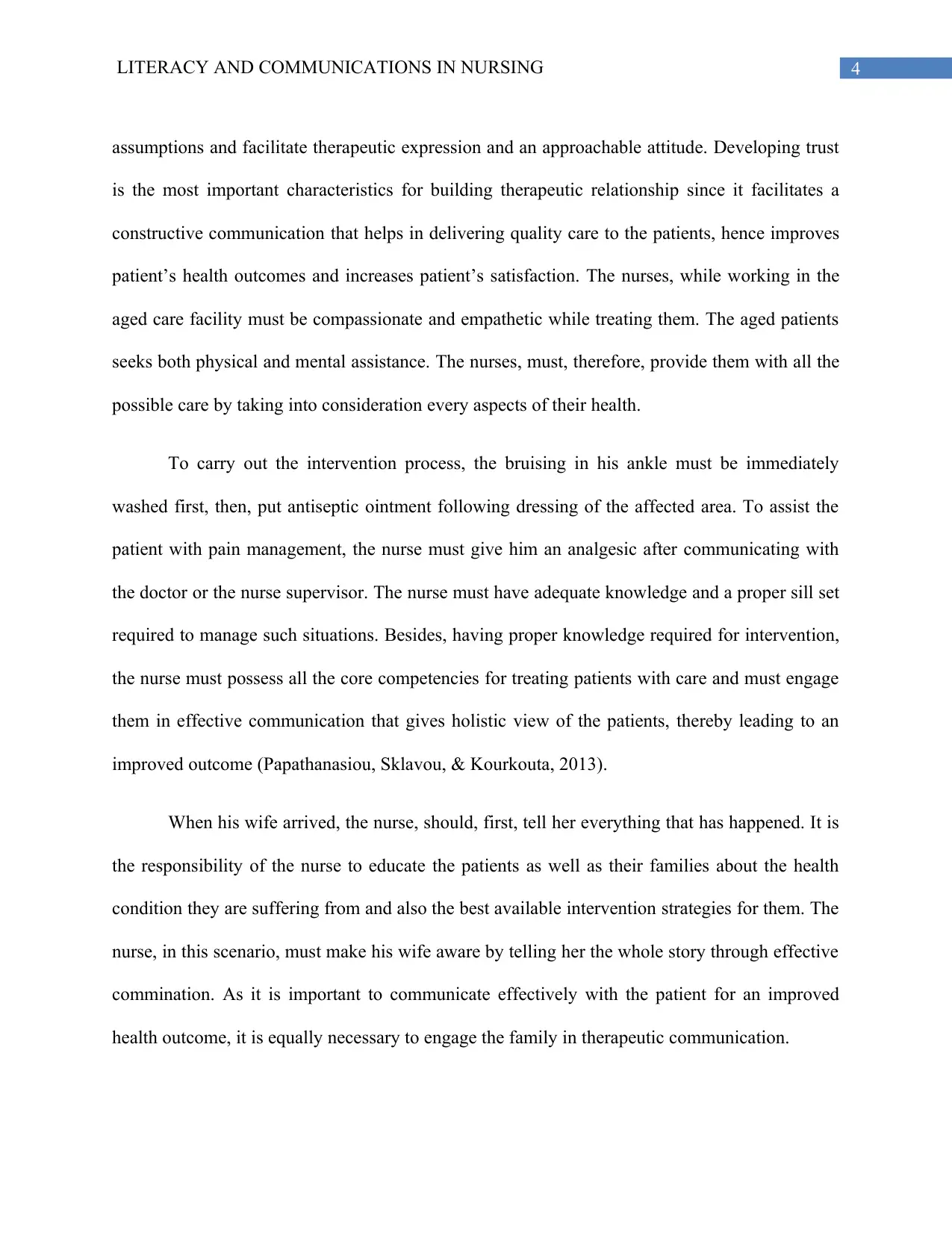
4LITERACY AND COMMUNICATIONS IN NURSING
assumptions and facilitate therapeutic expression and an approachable attitude. Developing trust
is the most important characteristics for building therapeutic relationship since it facilitates a
constructive communication that helps in delivering quality care to the patients, hence improves
patient’s health outcomes and increases patient’s satisfaction. The nurses, while working in the
aged care facility must be compassionate and empathetic while treating them. The aged patients
seeks both physical and mental assistance. The nurses, must, therefore, provide them with all the
possible care by taking into consideration every aspects of their health.
To carry out the intervention process, the bruising in his ankle must be immediately
washed first, then, put antiseptic ointment following dressing of the affected area. To assist the
patient with pain management, the nurse must give him an analgesic after communicating with
the doctor or the nurse supervisor. The nurse must have adequate knowledge and a proper sill set
required to manage such situations. Besides, having proper knowledge required for intervention,
the nurse must possess all the core competencies for treating patients with care and must engage
them in effective communication that gives holistic view of the patients, thereby leading to an
improved outcome (Papathanasiou, Sklavou, & Kourkouta, 2013).
When his wife arrived, the nurse, should, first, tell her everything that has happened. It is
the responsibility of the nurse to educate the patients as well as their families about the health
condition they are suffering from and also the best available intervention strategies for them. The
nurse, in this scenario, must make his wife aware by telling her the whole story through effective
commination. As it is important to communicate effectively with the patient for an improved
health outcome, it is equally necessary to engage the family in therapeutic communication.
assumptions and facilitate therapeutic expression and an approachable attitude. Developing trust
is the most important characteristics for building therapeutic relationship since it facilitates a
constructive communication that helps in delivering quality care to the patients, hence improves
patient’s health outcomes and increases patient’s satisfaction. The nurses, while working in the
aged care facility must be compassionate and empathetic while treating them. The aged patients
seeks both physical and mental assistance. The nurses, must, therefore, provide them with all the
possible care by taking into consideration every aspects of their health.
To carry out the intervention process, the bruising in his ankle must be immediately
washed first, then, put antiseptic ointment following dressing of the affected area. To assist the
patient with pain management, the nurse must give him an analgesic after communicating with
the doctor or the nurse supervisor. The nurse must have adequate knowledge and a proper sill set
required to manage such situations. Besides, having proper knowledge required for intervention,
the nurse must possess all the core competencies for treating patients with care and must engage
them in effective communication that gives holistic view of the patients, thereby leading to an
improved outcome (Papathanasiou, Sklavou, & Kourkouta, 2013).
When his wife arrived, the nurse, should, first, tell her everything that has happened. It is
the responsibility of the nurse to educate the patients as well as their families about the health
condition they are suffering from and also the best available intervention strategies for them. The
nurse, in this scenario, must make his wife aware by telling her the whole story through effective
commination. As it is important to communicate effectively with the patient for an improved
health outcome, it is equally necessary to engage the family in therapeutic communication.
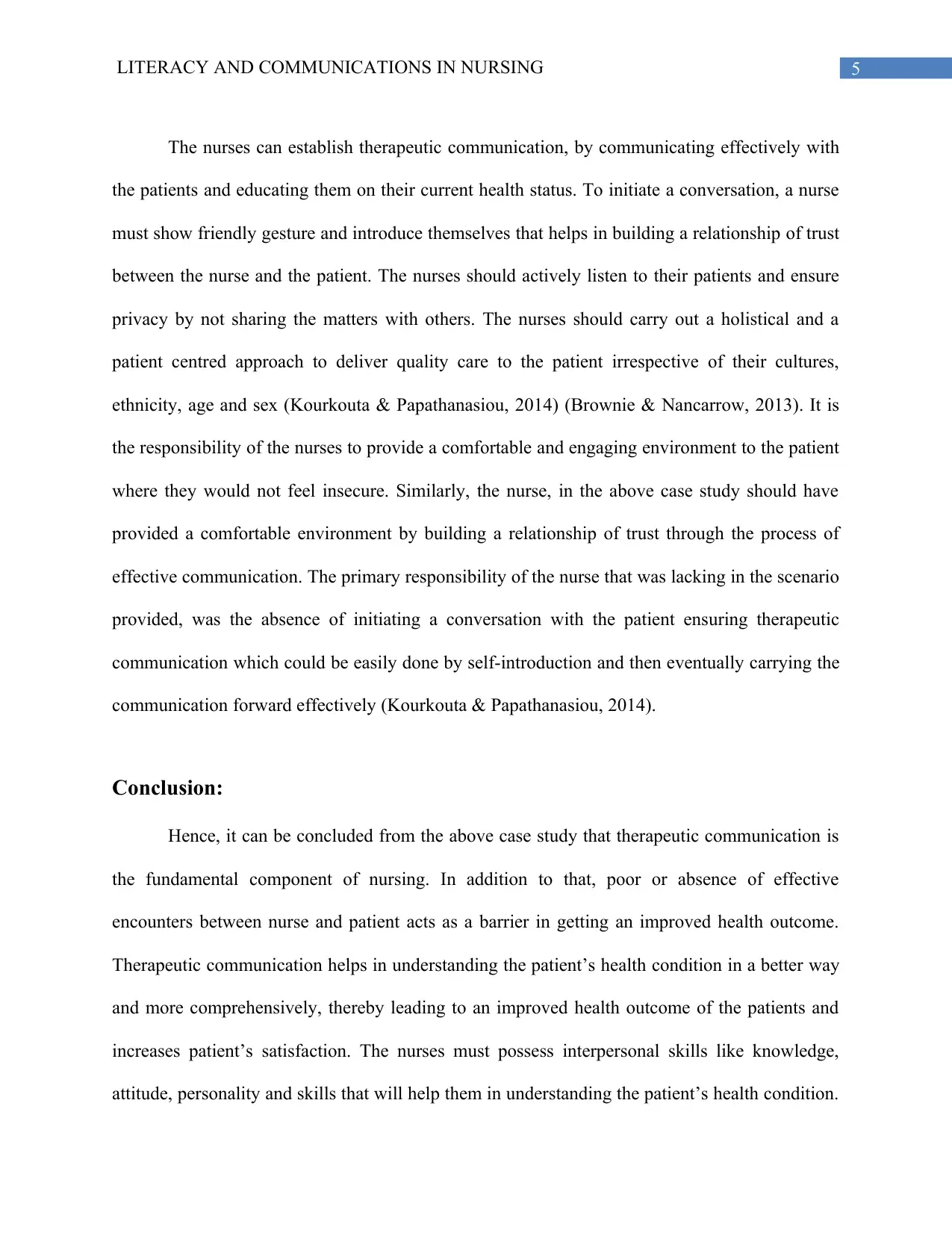
5LITERACY AND COMMUNICATIONS IN NURSING
The nurses can establish therapeutic communication, by communicating effectively with
the patients and educating them on their current health status. To initiate a conversation, a nurse
must show friendly gesture and introduce themselves that helps in building a relationship of trust
between the nurse and the patient. The nurses should actively listen to their patients and ensure
privacy by not sharing the matters with others. The nurses should carry out a holistical and a
patient centred approach to deliver quality care to the patient irrespective of their cultures,
ethnicity, age and sex (Kourkouta & Papathanasiou, 2014) (Brownie & Nancarrow, 2013). It is
the responsibility of the nurses to provide a comfortable and engaging environment to the patient
where they would not feel insecure. Similarly, the nurse, in the above case study should have
provided a comfortable environment by building a relationship of trust through the process of
effective communication. The primary responsibility of the nurse that was lacking in the scenario
provided, was the absence of initiating a conversation with the patient ensuring therapeutic
communication which could be easily done by self-introduction and then eventually carrying the
communication forward effectively (Kourkouta & Papathanasiou, 2014).
Conclusion:
Hence, it can be concluded from the above case study that therapeutic communication is
the fundamental component of nursing. In addition to that, poor or absence of effective
encounters between nurse and patient acts as a barrier in getting an improved health outcome.
Therapeutic communication helps in understanding the patient’s health condition in a better way
and more comprehensively, thereby leading to an improved health outcome of the patients and
increases patient’s satisfaction. The nurses must possess interpersonal skills like knowledge,
attitude, personality and skills that will help them in understanding the patient’s health condition.
The nurses can establish therapeutic communication, by communicating effectively with
the patients and educating them on their current health status. To initiate a conversation, a nurse
must show friendly gesture and introduce themselves that helps in building a relationship of trust
between the nurse and the patient. The nurses should actively listen to their patients and ensure
privacy by not sharing the matters with others. The nurses should carry out a holistical and a
patient centred approach to deliver quality care to the patient irrespective of their cultures,
ethnicity, age and sex (Kourkouta & Papathanasiou, 2014) (Brownie & Nancarrow, 2013). It is
the responsibility of the nurses to provide a comfortable and engaging environment to the patient
where they would not feel insecure. Similarly, the nurse, in the above case study should have
provided a comfortable environment by building a relationship of trust through the process of
effective communication. The primary responsibility of the nurse that was lacking in the scenario
provided, was the absence of initiating a conversation with the patient ensuring therapeutic
communication which could be easily done by self-introduction and then eventually carrying the
communication forward effectively (Kourkouta & Papathanasiou, 2014).
Conclusion:
Hence, it can be concluded from the above case study that therapeutic communication is
the fundamental component of nursing. In addition to that, poor or absence of effective
encounters between nurse and patient acts as a barrier in getting an improved health outcome.
Therapeutic communication helps in understanding the patient’s health condition in a better way
and more comprehensively, thereby leading to an improved health outcome of the patients and
increases patient’s satisfaction. The nurses must possess interpersonal skills like knowledge,
attitude, personality and skills that will help them in understanding the patient’s health condition.
⊘ This is a preview!⊘
Do you want full access?
Subscribe today to unlock all pages.

Trusted by 1+ million students worldwide

6LITERACY AND COMMUNICATIONS IN NURSING
When a nurse communicate effectively with the patient, it helps patients to cope up with
problems both physically and mentally.
References:
Abdolrahimi, M., Ghiyasvandian, S., Zakerimoghadam, M., & Ebadi, A. (2017). Therapeutic
communication in nursing students: A Walker & Avant concept analysis. Electronic
physician, 9(8), 4968.
Brownie, S., & Nancarrow, S. (2013). Effects of person-centered care on residents and staff in
aged-care facilities: a systematic review. Clinical interventions in Aging, 8, 1.
Kourkouta, L., & Papathanasiou, I. V. (2014). Communication in nursing practice. Materia
socio-medica, 26(1), 65.
Nursingmidwiferyboard.gov.au. (2019). Nursing and Midwifery Board of Australia -
Professional standards. Retrieved 19 August 2019, from
https://www.nursingmidwiferyboard.gov.au/Codes-Guidelines-Statements/Professional-
standards.aspx
Papathanasiou, I., Sklavou, M., & Kourkouta, L. (2013). Holistic nursing care: theories and
perspectives. American Journal of Nursing Science, 2(1), 1-5.
Riley, J. B. (2015). Communication in nursing. Elsevier Health Sciences.
Sleeper, J. A., & Thompson, C. (2008). The use of hi fidelity simulation to enhance nursing
students' therapeutic communication skills. International Journal of Nursing Education
Scholarship, 5(1), 1-12.
When a nurse communicate effectively with the patient, it helps patients to cope up with
problems both physically and mentally.
References:
Abdolrahimi, M., Ghiyasvandian, S., Zakerimoghadam, M., & Ebadi, A. (2017). Therapeutic
communication in nursing students: A Walker & Avant concept analysis. Electronic
physician, 9(8), 4968.
Brownie, S., & Nancarrow, S. (2013). Effects of person-centered care on residents and staff in
aged-care facilities: a systematic review. Clinical interventions in Aging, 8, 1.
Kourkouta, L., & Papathanasiou, I. V. (2014). Communication in nursing practice. Materia
socio-medica, 26(1), 65.
Nursingmidwiferyboard.gov.au. (2019). Nursing and Midwifery Board of Australia -
Professional standards. Retrieved 19 August 2019, from
https://www.nursingmidwiferyboard.gov.au/Codes-Guidelines-Statements/Professional-
standards.aspx
Papathanasiou, I., Sklavou, M., & Kourkouta, L. (2013). Holistic nursing care: theories and
perspectives. American Journal of Nursing Science, 2(1), 1-5.
Riley, J. B. (2015). Communication in nursing. Elsevier Health Sciences.
Sleeper, J. A., & Thompson, C. (2008). The use of hi fidelity simulation to enhance nursing
students' therapeutic communication skills. International Journal of Nursing Education
Scholarship, 5(1), 1-12.
Paraphrase This Document
Need a fresh take? Get an instant paraphrase of this document with our AI Paraphraser
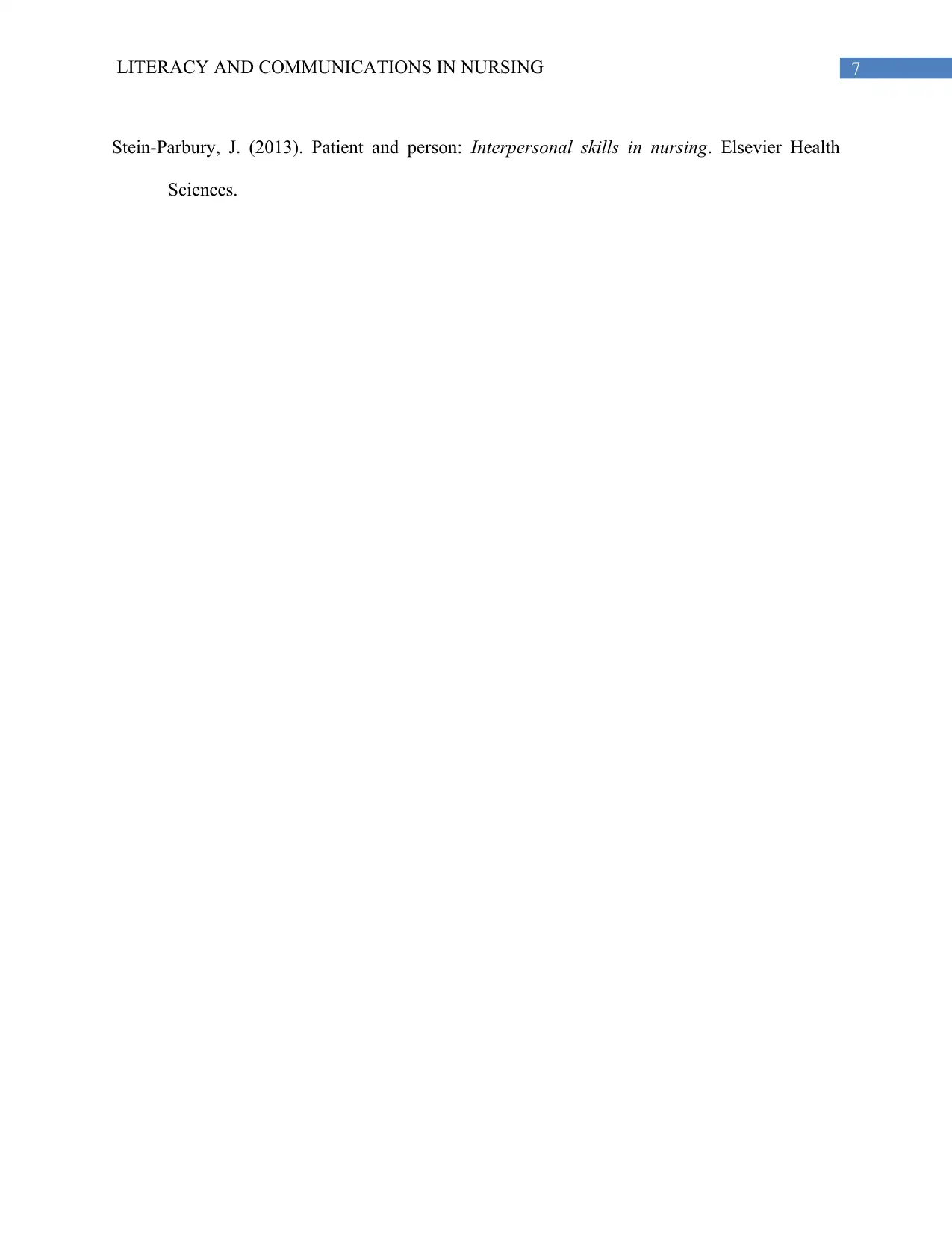
7LITERACY AND COMMUNICATIONS IN NURSING
Stein-Parbury, J. (2013). Patient and person: Interpersonal skills in nursing. Elsevier Health
Sciences.
Stein-Parbury, J. (2013). Patient and person: Interpersonal skills in nursing. Elsevier Health
Sciences.
1 out of 8
Related Documents
Your All-in-One AI-Powered Toolkit for Academic Success.
+13062052269
info@desklib.com
Available 24*7 on WhatsApp / Email
![[object Object]](/_next/static/media/star-bottom.7253800d.svg)
Unlock your academic potential
Copyright © 2020–2025 A2Z Services. All Rights Reserved. Developed and managed by ZUCOL.





